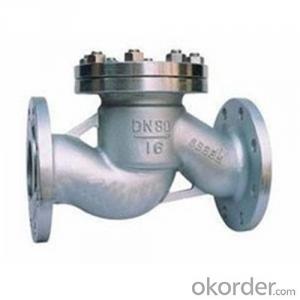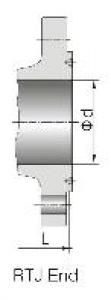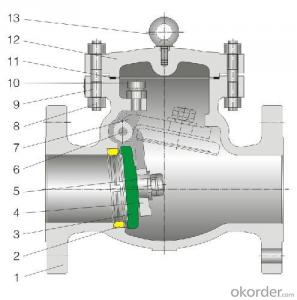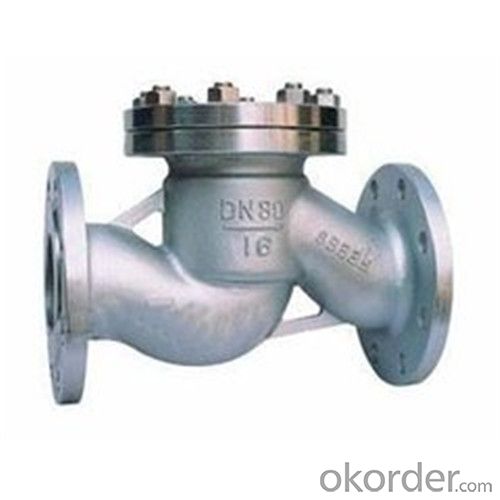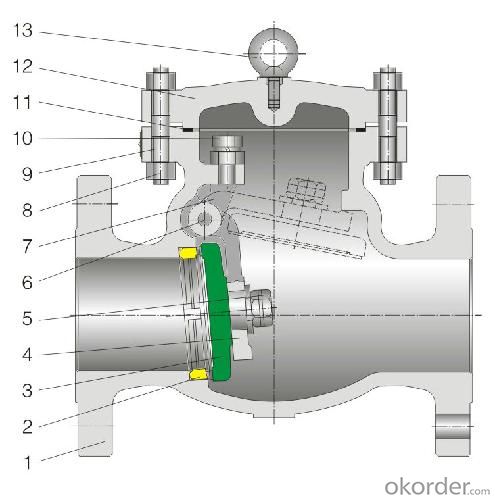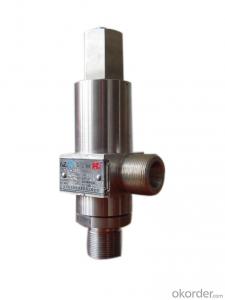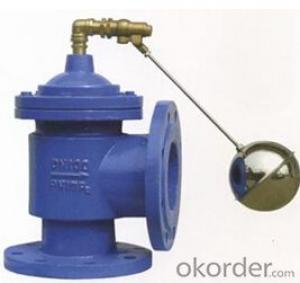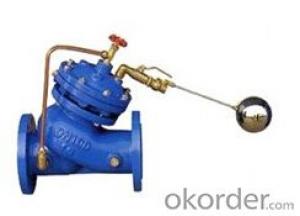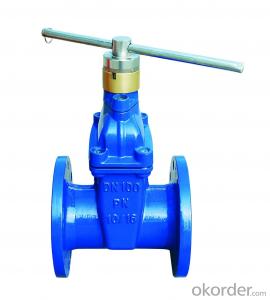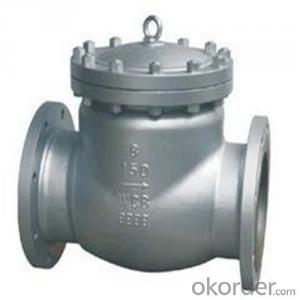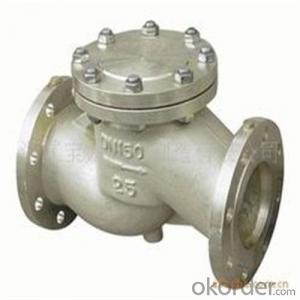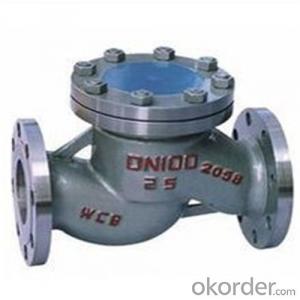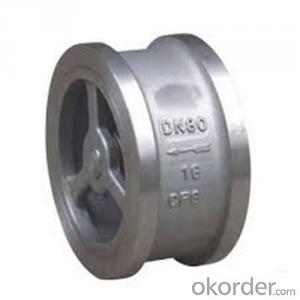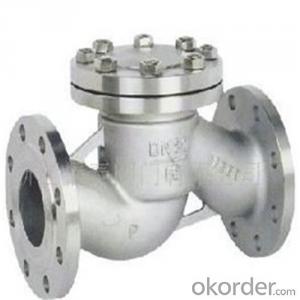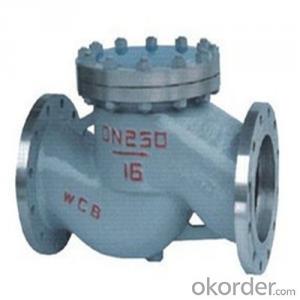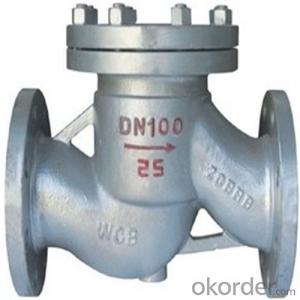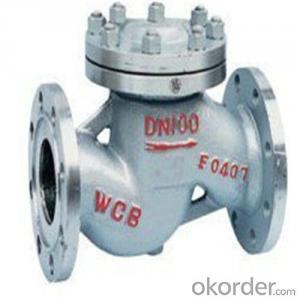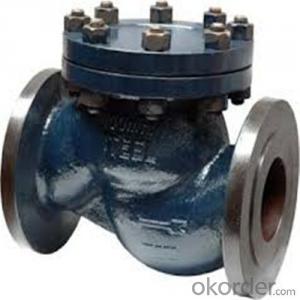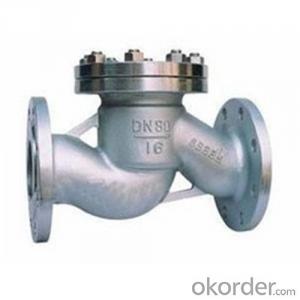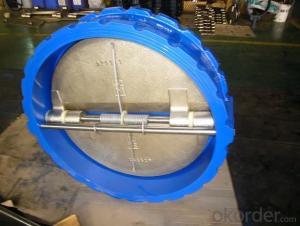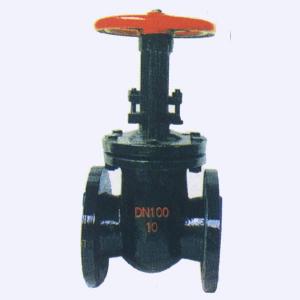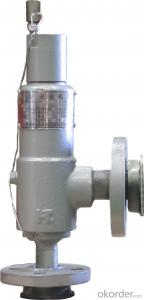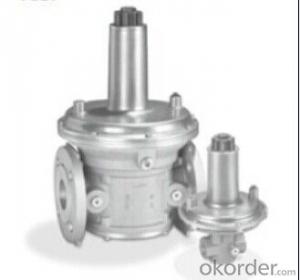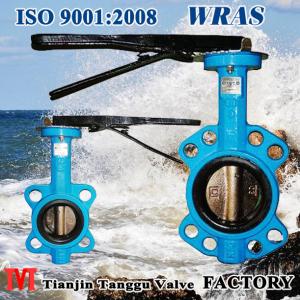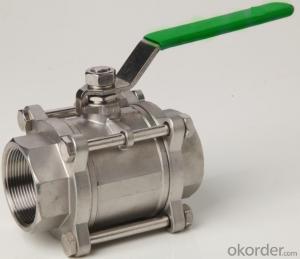API Cast Steel Lift Check Valve Size 450 mm
- Loading Port:
- Shanghai
- Payment Terms:
- TT OR LC
- Min Order Qty:
- 10 pc
- Supply Capability:
- 100 pc/month
OKorder Service Pledge
OKorder Financial Service
You Might Also Like
API Cast Steel Lift Check Valve 150 Class
The features of Cast Steel Lift Check Valve
Bolted Bonnet;Swing and lift disc;Metallic seating surfaces.
Body and Bonnet Connection of Cast Steel Lift Check Valve:
The body and bonnet of Class150~Class900 check valves are usually with studs and nuts.And the body and bonnet of Class1500~Class2500 check valves are usually of pressurized seal design.
Body-To-Bonnet Joint of Cast Steel Lift Check Valve:
Stainless steel + flesible graphite wounded gasket is used for Class 150 and Class 300 check valve;Stainless steel + flexible graphite wounded gasket is used for Class 600 check valve,and joint gasket is also optional for Class 600 check valve;Ring joint gasket is used for Class900 check valve;Pressurized seal design is used for Class 1500~Class 2500 check valves.
Seat of Cast Steel Lift Check Valve:
For carbon steel check valve,the seat is usually forged steel.The sealing surface of the seat is spray welded with hard alloy specified by the customer.Renewable threaded seat is used for NPS<10 check="" valves="" and="" welded="" on="" seat="" can="" be="" also="" optional="" if="" being="" requested="" by="" the="" customer.welded="" is="" used="" for="" nps="">12 crbon steel gate valves .Forstainless steel check valve,integral seat is usually adopted ,or to weld hard alloy directly integrally.Threaded or welded on seat is also optional for stainless steel check valve if being requested by the customer.
Parameter of Cast Steel Check Valve:
Standard Criteria | ASME/ANSI/API customize |
Pressure Rating | 150 Class 300 Class 600 Class 900 Class 1500 Class 2500 Class customize |
Valve Size | 50 mm 65 mm 80 mm 100 mm 125 mm 150 mm 200 mm 250 mm 300 mm 350 mm 400 mm 450 mm 500 mm 600 mm 650 mm 700 mm 750 mm |
2 inch 2.5 inch 3 inch 4 inch 5 inch 6 inch 8 inch 10 inch 12 inch 14 inch 16 inch 18 inch 20 inch 24 inch 26 inch 28 inch 30 inch customize | |
Actuator | Automatic customize |
Connection | Butt Welding Flange RF Flange RTJ customize |
1-Body Material | A216 WCB A351-CF8 A351-CF8M customize |
2-Seat ring | A351-CF8 A351-CF8M A105+13Cr Tool Steel+A105 customize |
3-Disc | Tool Steel+A216 WCB A351-CF8M A351-CF8 A216 WCB+13Cr customize |
4-Arm | A351-CF8 A216 WCB A351-CF8M customize |
5-Nut | A194 8M A194-8 A194 2H customize |
6-Arm pin | A182-F6a A182-F316 A182-F304 customize |
7-Yoke | A351-CF8 A351-CF8M A216 WCB customize |
8-Bonnet nut | A194 8M A194-8 A194 2H customize |
9-Bonnet bolt | A193-B8 A193-B8M A193-B7 customize |
10-Bolt | A193-B7 A193-B8 A193-B8M customize |
11-Gasket | graphite+304 graphite+316 customize |
12-Bonnet | A216 WCB A351-CF8M A351-CF8 customize |
13-Eye bolt | A181 customize |
Design Standard | API 6D BS 1868 customize |
Connection Standard | API 605 ASME B 16.25-2007 ASME B 16.47A ASME B 16.47B ASME B 16.5 MSS SP-44 customize |
Test Standard | API 598 API 6D customize |
Face to Face | ASME B 16.10 customize |
Pressure-temperature ratings | ASME B 16.34-2004 customize |
Wall thickness dimension | API 600 BS 1868 |
FAQ of Cast Steel Check Valve:
Q1:I can’t find the type of steel check valve which I need. what can I do?
The chart above only lists out some common composition of steel check valve parts.We may provide other different parts material composition according to the customer's request or the actual valve working condition.
Q2:Which certification do your products pass?
Our products are in accordance with ISO 9001、ISO 14001、API 6A、API 6D、TS CE、API607/6FA/BS6755.
- Q: Hi. I am planning to install new kitchen faucet and noticed that there are two shut off valves under the sink. One of them is badly rusted and needs to be replaced. I noticed that it is connected to three pipes (one of which is kitchen faucet). The other is clearly water coming in. What is the third one connected to wall? Also how should I go about replacing this? Anything that I should be careful of?
- make a drawing of what you have. . .take it to Home Depot or better yet, a plumbing suppy place. They will be able to replace what you have. Just replace what you have and it will work. The interesting thing about shutoff valves is that they are always broken when you need them and work when you don't. They last no longer than what you are protecting. Buy the best ones they have. I have a strange one that is connected to three pipes. . .the water comes in one and goes out to the faucet and the dishwasher. . .three pipes. That's the hot water. And then the cold water comes in and goes up to the faucet. .the second shutoff.
- Q: I have a 1989 Jeep Cherokee with 218,700 miles on it and my engine has thick oily gunk on it, possibly from a leaky valve cover gasket, should I change the gasket? I have been told that this is normal and not to worry about, but from the amount of this gunk, I find it hard to believe this is normal. The top of the valve cover has a light covering of gunk, but on the sides and towards the bottom of the engine. it gets very thick and at some places you can't even make out whats suppose there. Does a leaky valve cover gasket mean that there is another problem going on?Can leaving the oily gunk on the engine cause any problems?Any info would be greatly appreciated.
- Usually, a leaky valve cover gasket is just that. A leaky valve cover gasket. Unless you are building up high internal pressure from a clogged PCV for example and literally forcing the oil out the weakest point, there usually is no underlying issue. Leaving the oily gunk does a couple things. If its on rubber such as any hoses that aren't oil resistant, they will degrade quickly. The same can goes for wiring insulation, motor mounts, or even the rubber seals on some of your front end pieces. Also, wrapping an engine in a thick layer of goo doesn't let it cool as it should and puts more thermal burden on it. What you do at this point is a question of how much longer a 1989 Jeep with 218,700 miles will go or how much longer you want to keep it.
- Q: hi im 13 years old and i am having my tricuspid valve repaired or replaced the doctors do know what they are going to do yet.what is the success rate of the operation ?and whats the survival rate of the operation ?all other info would be appreciatedthanksalex
- you in straightforward terms choose surgical operation whether it rather is ruining your life or if the surgeon thinks it is going to without warning worsen. Open coronary heart surgical operation contains an significant possibility. in the event that they carried out it on each and every case of something being incorrect, greater human beings could be worse off after the surgical operation than till now the surgical operation.
- Q: I am replacing the Camshaft, lifters, and timing chain on a SBC 350. The motor is still in the car and I have the valve covers and manifold removed (and other components). The camshaft break-in procedure recommends removing the inner valve springs and running engine at 2000-2500 rpm for 20-30 minutes. MY QUESTION: I have the valve spring compressor tool to remove the springs. HOW do I prevent the valve from falling into the cylinder when I remove the spring? Can I conduct the break in without removing the inner valve springs?
- the reason they want you to remove the inner springs is so that there won't be too much valve spring pressure pressing down on the cam lobes. Too much valve spring pressure on a new cam will eat up the cam lobes. You can also find some weaker valves springs to run just during the break in and then swap them out for the correct springs you are going to run permanently. The easiest way to keep the valve from falling in the cylinder is to use a compression gauge hose. Remove the schraeder valve from the end of the hose that screws in the spark plug hole. Now you can connect an air hose with compressed are into the cylinder. that's how everyone I know has ever changed valve springs.
- Q: Hello all,I have a1990,BMW 525i.I bought this car from another guy about year back and drive around 13000 kms.1.Do i need to adjust the valves(both inlet and outlet).2What is the importance of valve adjustment3Does it affect the mileage4.As a regular maintenance for how many kms can i drive without valve adjustmentExpecting your valuable replies.
- um...yes, no,,no and yes. no really all i know is correct clearance is important and if incorrect, it can do some damage. it does affect mileage, and both intake and exhaust need adjustment and i would recommend a professional technician. it is sometimes difficult for even a pro to adjust valves. i don't do it often at work, but had some trouble on my own car. had to remove the cover and change a couple cuz they were noisy after made the first adjustment.
- Q: so, im a day away from getting a 2002 748 and im super excited, iv always wanted a ducati, and i cant wait to have one of my own. i understand that ducks have a reputation of breaking and im prepared for it. I also understand the valves need to be adjusted every 50-100 feet :P all kidding aside i know every 6k miles they need to be adjusted. i dont know however how much it costs to have the valves adjusted. im sure it varys from shop to shop but a ball park quote would be really helpful just so its not a kick in the gut when i take it in for the first time. thanks
- Well first, you need to get them inspected, and they'll only adjust the valves if it's needed, even at 6k mile intervals, if your valves are still in spec or very close without lobe drag, they probably won't be changed, so check your bill and ask your tech directly if they were changed, some less reputable dealers may try to pull a fast one on you. If you actually needed ALL 16 shims changed, you're easily talking $1000 in labor, esp. on the 748/916 style heads, which have access ports on the heads instead of being able to remove the whole top of the heads like the newer DESMOQUATTRO heads, and are a PITA to work on because of it. The bad thing is that until recently (and they still need improvement) Ducati's quality control is lower than other manufacturers, meaning very inconsistent performance reliability, just from variances in manufacturing. If you get a GOOD tech to do the bike right in the first place though, not just valves but all-important TPS resetting, cam timing/belt tension, and balanced CO's in your exhaust, you will have a lot less headaches with your Duc.
- Q: Holding my right hand up, I am a newbie :) any help is greatly appreciated.a) Comparing the shape of the valve to a golf tee, what is the correct name for the thinnest section of the valve(the part of the golf tee that goes into the ground)b) What is the correct name for the widest section of the valve(the part of the golf tee that the ball is placed on.c) The cylinder that the valve moves up and down in, is it just called the valve cylinder?d) In the valve cylinder?, how does the widest part of the valve keeps things sealed. Does it use a ring(simmilar to pistons) or is it some type of gasket material or is it just zero clearance metal to metal.e) The section of the (valve cylinder?) that is above the seal point or basicaly where the valve spring and the thinnest part of the valve is, does oil flow through here?f) Do (valve cylinders?) generate enough heat to warrant the need for coolant?Newbie City, I know. Any help is GREATLY appreciated.TY
- a) The very end is the tip. Below that are grooves that the keepers lock into. This is actually the thinnest part. Below that is the rest of the stem. The general name for the largest part in total is the valve head. b) Surface sounds right. Hadn't really thought about it before. LOL c) Valve Guide. These can either be just a plain hole in the cylinder head material, or often they have bronze inserts. Plain Guides are often repaired by a process called knurling. d) Valves seal to the head by grinding each at the same angle, (usually 45 degrees) and then they are lapped which is where an abrasive compound is placed in between, and the valve is rotated. This matches the surfaces more closely yet. The parts that seal are called the valve face and the seat which is actually a separate part that is inserted into the head, and can be replaced. e) Oil is supplied to that general area, by either holes in pushrods that lubricate the rocker arm, or in the case of rockers mounted to a shaft, through the shaft. In the first case, oil is supplied by the hydraulic lifters. In the latter, the shaft pedestals are drilled for oil passages. In both cases, oil is present in the area, but is not applied directly to the valves. In fact, the job of the valve stem seal is to keep too much oil from getting in the guides. f) Usually the coolant flowing through the heads is enough to carry away the heat, although some hi-performance engines employ techniques such as hollow exhaust valves filled with sodium. Most normal valves are solid.
- Q: Does anyone know where i can get a chromed valve cover for a 99 eclipse or is there a way that i can do it myself? id like to get one that has the etched 2.0 and DOHC words on it
- You can have it dipped in chrome and detailed for the lettering. It pricey but its the best way or you could try finding chrome spray paint that is good up to 500 degrees and do it yourself but it may not look as good.
- Q: where is the fuel tank selector valve located on the truck?
- Located under the LH center of vehicle, on LH frame rail
- Q: Hello. I am interested in purchasing a Hydroclean Fill Valve for my toilet. Are these good fill valves? Thanks!
- who cares, a toilet fill valve only costs a few bucks. as long as it opens and closes it's a good valve. if it only lasts for a year then it's a piece of junk and you should try another brand. it's not a major decision
Send your message to us
API Cast Steel Lift Check Valve Size 450 mm
- Loading Port:
- Shanghai
- Payment Terms:
- TT OR LC
- Min Order Qty:
- 10 pc
- Supply Capability:
- 100 pc/month
OKorder Service Pledge
OKorder Financial Service
Similar products
Hot products
Hot Searches
Related keywords
